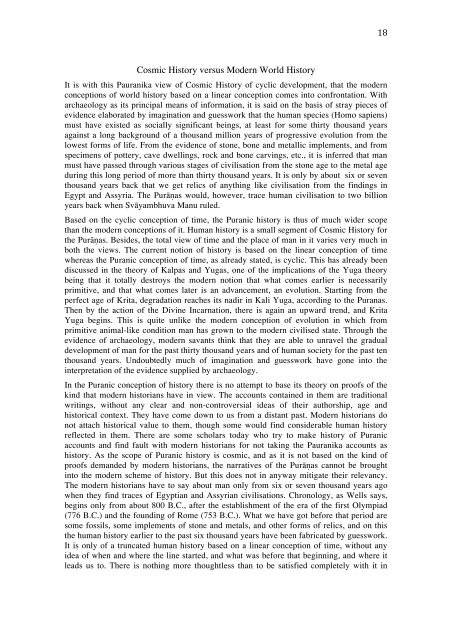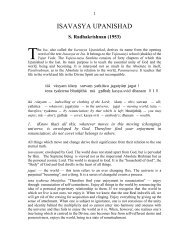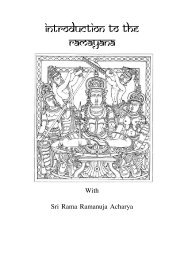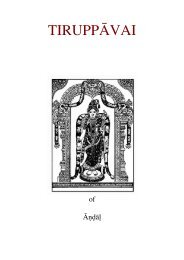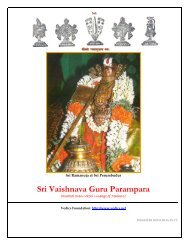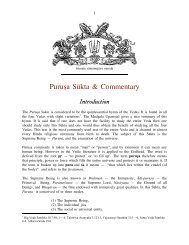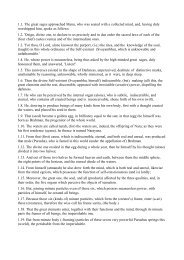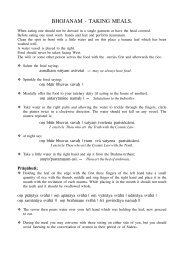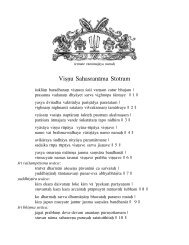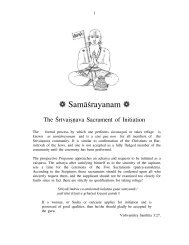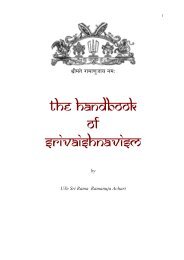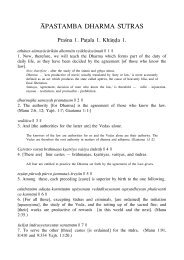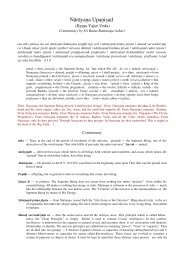18 Cosmic History versus Modern World HistoryIt is with this Pauranika view of Cosmic History of cyclic development, that the modernconceptions of world history based on a linear conception comes into confrontation. Witharchaeology as its principal means of information, it is said on the basis of stray pieces ofevidence elaborated by imagination and guesswork that the human species (Homo sapiens)must have existed as socially significant beings, at least for some thirty thousand yearsagainst a long background of a thousand million years of progressive evolution from thelowest forms of life. From the evidence of stone, bone and metallic implements, and fromspecimens of pottery, cave dwellings, rock and bone carvings, etc., it is inferred that manmust have passed through various stages of civilisation from the stone age to the metal ageduring this long period of more than thirty thousand years. It is only by about six or seventhousand years back that we get relics of anything like civilisation from the findings inEgypt and Assyria. The Purāṇas would, however, trace human civilisation to two billionyears back when Svāyambhuva Manu ruled.Based on the cyclic conception of time, the Puranic history is thus of much wider scopethan the modern conceptions of it. Human history is a small segment of Cosmic History forthe Purāṇas. Besides, the total view of time and the place of man in it varies very much inboth the views. The current notion of history is based on the linear conception of timewhereas the Puranic conception of time, as already stated, is cyclic. This has already beendiscussed in the theory of Kalpas and Yugas, one of the implications of the Yuga theorybeing that it totally destroys the modern notion that what comes earlier is necessarilyprimitive, and that what comes later is an advancement, an evolution. Starting from theperfect age of Krita, degradation reaches its nadir in Kali Yuga, according to the Puranas.Then by the action of the Divine Incarnation, there is again an upward trend, and KritaYuga begins. This is quite unlike the modern conception of evolution in which fromprimitive animal-like condition man has grown to the modern civilised state. Through theevidence of archaeology, modern savants think that they are able to unravel the gradualdevelopment of man for the past thirty thousand years and of human society for the past tenthousand years. Undoubtedly much of imagination and guesswork have gone into theinterpretation of the evidence supplied by archaeology.In the Puranic conception of history there is no attempt to base its theory on proofs of thekind that modern historians have in view. The accounts contained in them are traditionalwritings, without any clear and non-controversial ideas of their authorship, age andhistorical context. They have come down to us from a distant past. Modern historians donot attach historical value to them, though some would find considerable human historyreflected in them. There are some scholars today who try to make history of Puranicaccounts and find fault with modern historians for not taking the Pauranika accounts ashistory. As the scope of Puranic history is cosmic, and as it is not based on the kind ofproofs demanded by modern historians, the narratives of the Purāṇas cannot be broughtinto the modern scheme of history. But this does not in anyway mitigate their relevancy.The modern historians have to say about man only from six or seven thousand years agowhen they find traces of Egyptian and Assyrian civilisations. Chronology, as Wells says,begins only from about 800 B.C., after the establishment of the era of the first Olympiad(776 B.C.) and the founding of Rome (753 B.C.). What we have got before that period aresome fossils, some implements of stone and metals, and other forms of relics, and on thisthe human history earlier to the past six thousand years have been fabricated by guesswork.It is only of a truncated human history based on a linear conception of time, without anyidea of when and where the line started, and what was before that beginning, and where itleads us to. There is nothing more thoughtless than to be satisfied completely with it in
19 spite of all its limitations, and close our eyes entirely to the pre-historic Cosmic Historythat the Purāṇas give us. At least to keep an open mind is what common sense woulddictate. Scholars who are brought up in the closed mentality that the study of suchtruncated and circumscribed history develops, will do well to enlarge their vision by takingup the study of subjects like Proto-history and Cosmic History that the Purāṇas canprovide. 1 It will help them at least to feel that the past of man is not that short and simple asmade out by the very limited history of their acquaintance. It will save them from the sortof error at which H. G. Wells casts ridicule in his Outline of History as follows:–"In the European world, until a little more than a century and a half ago, men's ideas ofthe time things had lasted were astonishingly brief. In the Universal History published bya syndicate of booksellers in London in 1799, it is stated that the world was created in4004 B.C. and (with a pleasant exactitude) at the autumnal equinox, and that the makingof man crowned the work of creation at Eden upon the Euphrates, exactly two days'journey above Basra"And in contrast to this, the same author admires the Indian thinkers, stating: "Among theancient people, the Indian philosopher alone seems to have had any perception of the vastages through which existence has passed." Can it not be that our modern historians too aremaking a similar mistake?The Pauranikas will say that their accounts are traditions based on the intuition, inspirationand revelation that have come to wise men. Even if it is accepted, intuition and revelationspassing down through ages undergo elaborations and distortions in the hands of men, justas the materials obtained from archaeology, or even records, come up as history only afterthey are dressed up in human imagination. As the counts on both sides, in favour andagainst, are more or less equal, both versions of the past may be taken for what they areworth, without dogmatism and exclusive claims on either side. The linear conception ofhistory as understood today may be giving us something exact about man's recent past, butit has nothing meaningful to say about man's distant past, his future, and his significance incosmic history. Here the Pauranika cyclic conception of cosmic history comes in, giving ameaningful interpretation of man as an intelligent being, amidst other species of intelligentbeings, evolving towards higher levels of perfection. As man is thus raised frommeaninglessness to meaningfulness, the Pauranika cyclic history is a source of spiritualenrichment, an encouragement to the human mind, though it looks uninviting to amaterialist with a very limited and clouded outlook. Where there is absolute darkness, it isbetter to have some light, though it be from speculation. And speculation has been theprecursor of definite knowledge even in the history of science. Further, this apotheosis ofarchaeology, making it the arbiter of man's distant past, is a kind of dogmatism, nay,superstition.The Idea of Evolution in the PurāṇasUnlike in the modern view, evolution has no application to the growth of various species ofbeings or to human civilisation in this Pauranika view of cyclic evolution. It has, however,application in regard to the resurgence (Sarga) of the twenty-four cosmic categoriesevolving out of Prakriti and forming the Cosmic Shell. The order of the evolution of these1 An attempt in this line is the recent publication of Inter-India Publications, 105, Anand Nagar.New Delhi, 'History of the Pre-Kali-Yuga India' by Sri R. Siddhanta Shastry.
- Page 3 and 4: 3 by turn, as it were, thus display
- Page 5 and 6: 5 Purāṇa, thus relegating the Vi
- Page 8 and 9: 8 There is, however an anomalous ci
- Page 11: 11 Viṣṇu conception, and that i
- Page 20 and 21: 20 categories, the succeeding from
- Page 22 and 23: 22 the lie to the modern theory tha
- Page 24 and 25: 24 much vaunted historicity of Chri
- Page 26 and 27: 26 In an Introduction to a Text lik
- Page 28 and 29: 28 connoisseur of the sentiment of
- Page 30 and 31: 30 the Sattvika manifestation of V
- Page 32 and 33: 32 There is no Limit to the Number
- Page 34 and 35: 34 and divided by the good and kind
- Page 36 and 37: 36 joyous memory of His service, an
- Page 38 and 39: 38 asunder by roaming elephant herd
- Page 40 and 41: 40 means by which the darkness of i
- Page 42 and 43: 42 Suta said:- 40. Still Arjuna did
- Page 44 and 45: 44 22. Salutations to the One havin
- Page 46 and 47: 46 sorrow at, the death of all frie
- Page 48 and 49: 48 His mind was free from all sinfu
- Page 50 and 51: 50 11-12. Spiritual aspirants who h
- Page 52 and 53: 52 ever satisfied with his own blis
- Page 54 and 55: 54 Skandha 1: Chapter 12THE BIRTH O
- Page 56 and 57: 56 and returned to Hastinapura, hav
- Page 58 and 59: 58 them at His will. 41. Just as a
- Page 60 and 61: 60 Arjuna's Return in utter Distres
- Page 62 and 63: 62 sought by Indra and the Devas fo
- Page 64 and 65: 64 that state of absolute purity, w
- Page 66: 66 subject to any diminution in K
- Page 69 and 70:
69 degeneration. 6. No doubt Kali,
- Page 71 and 72:
71 connected with these crimes. Man
- Page 73:
73 Arrival of Sri Suka (25-40)25. W


